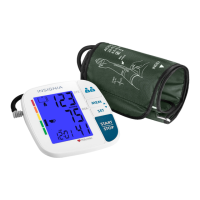5
www.insigniaproducts.com
Blood Pressure Monitor
• On the rare occasion of a fault causing the cuff to remain fully inflated
during measurement, open the cuff immediately. Prolonged high
pressure (cuff pressure >300 mm Hg or constant pressure >15 mm Hg
for more than three minutes) applied to the arm may lead to an
ecchymosis.
• Please check that operation of the device does not result in
prolonged impairment of the patient’s blood circulation.
• When measuring, please avoid compression or restriction of the
connection tubing.
• The device cannot be used with HF surgical equipment at the same
time.
• The accompanying documents will disclose that the
SPHYGMOMANOMETER was clinically investigated according to the
requirements of ISO 81060-2:2013.
•To verify the calibration of the AUTOMATED SPHYGMOMANOMETER,
please contact the manufacturer.
• This device is contraindicated for any female who may be or is
pregnant. Besides providing inaccurate readings, the effects of this
device on the fetus are unknown.
• Too frequent and consecutive measurements could cause
disturbances in blood circulation and injuries.
• This unit is not suitable for continuous monitoring during medical
emergencies or operations. Otherwise, the patient’s arm and fingers
will become anaesthetic, swollen, and even purple due to a lack of
blood.
• When not in use, store the device in a dry room and protect it against
extreme moisture, heat, lint, dust, and direct sunlight. Never place
any heavy objects on the storage case.
• This device may be used only for the purpose described in these
accompanying documents. The manufacturer cannot be held liable
for damage caused by incorrect application.
• This device comprises sensitive components and must be treated
with caution. Observe the storage and operating conditions
described in these accompanying documents.
• The equipment is not AP/APG equipment and not suitable for use in
the presence of a flammable anesthetic mixture with air of with
oxygen or nitrous oxide.
• Warning: No servicing/maintenance while the ME equipment is in
use.
• The patient is an intended operator.

